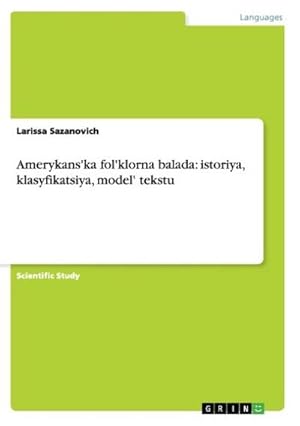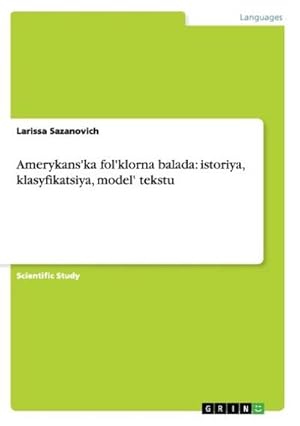Larissa Sazanovich (2 results)
Product Type
- All Product Types
- Books (2)
- Magazines & Periodicals
- Comics
- Sheet Music
- Art, Prints & Posters
- Photographs
- Maps
-
Manuscripts &
Paper Collectibles
Condition
- All Conditions
- New
- Used
Binding
- All Bindings
- Hardcover
- Softcover
Collectible Attributes
- First Edition
- Signed
- Dust Jacket
- Seller-Supplied Images
- Not Printed On Demand (1)
Seller Location
Seller Rating
-
Amerykans'ka fol'klorna balada: istoriya, klasyfikatsiya, model' tekstu
Published by GRIN Verlag Jul 2014, 2014
ISBN 10: 3656701210ISBN 13: 9783656701217
Seller: BuchWeltWeit Ludwig Meier e.K., Bergisch Gladbach, Germany
Book Print on Demand
Taschenbuch. Condition: Neu. This item is printed on demand - it takes 3-4 days longer - Neuware -Scientific Study from the year 2014 in the subject Russian / Slavic Languages, , course: Folkloristics, language: Russian, abstract: The book in Ukrainian addresses the phenomenon of figured stereotypification as a model of the text configuration. Stereotypification is defined as a process of text production by means of formulas fixed in the corporate memory. The English-American Folklore Ballad (EAFB) developed from the medieval English balladry tradition having adopted its models. The formal method of research was used to explore themes, plot, contents and narrative segments of EAFB. Findings of the study indicate a list of fixated themes including songs about love, conflicts related to social events, and sensations. Ballad plot structure, its stereotyped content and essential narrative segments were closely examined. 'Time' and 'place' in EAFB is realistic. 'Place' usually corresponds to the location of a ballad's principal character. Ballad conflicts are centered around individual status of the principal 'characters'. Helpers as well as neutral characters are specified according to the set of their distinctive features. There are 19 'functions' of EAFB characters defined: misfortune announced; obstacles revealed; marriage; bargain; questioning; information delivered; moralistic wishes; temporal being away; stimulus; response to stimulus; everyday activity; courting; conflict of interests; obstacle elimination; outcomes defined; choosing new life direction; coming back home; and transfiguration. The research results demonstrate that in the preliminary part of an EAFB the character usually receives an urging to action sign. In the basic part the tension grows. In the ending the outcomes of the conflict are revealed. The 'casual' segment of a ballad narration consists of motifs and intentions of characters. A personage comes to action because his / her interests have been harmed. Sometimes the main character is performing his / her duties. The results are revealed in the 'factual' segment. The purpose of an EAFB is to impart a moral or teach a lesson. 200 pp. Russisch.
-
Amerykans'ka fol'klorna balada: istoriya, klasyfikatsiya, model' tekstu
Published by GRIN Verlag, 2014
ISBN 10: 3656701210ISBN 13: 9783656701217
Seller: AHA-BUCH GmbH, Einbeck, Germany
Book
Taschenbuch. Condition: Neu. Druck auf Anfrage Neuware - Printed after ordering - Scientific Study from the year 2014 in the subject Russian / Slavic Languages, , course: Folkloristics, language: Russian, abstract: The book in Ukrainian addresses the phenomenon of figured stereotypification as a model of the text configuration. Stereotypification is defined as a process of text production by means of formulas fixed in the corporate memory. The English-American Folklore Ballad (EAFB) developed from the medieval English balladry tradition having adopted its models. The formal method of research was used to explore themes, plot, contents and narrative segments of EAFB. Findings of the study indicate a list of fixated themes including songs about love, conflicts related to social events, and sensations. Ballad plot structure, its stereotyped content and essential narrative segments were closely examined. 'Time' and 'place' in EAFB is realistic. 'Place' usually corresponds to the location of a ballad's principal character. Ballad conflicts are centered around individual status of the principal 'characters'. Helpers as well as neutral characters are specified according to the set of their distinctive features. There are 19 'functions' of EAFB characters defined: misfortune announced; obstacles revealed; marriage; bargain; questioning; information delivered; moralistic wishes; temporal being away; stimulus; response to stimulus; everyday activity; courting; conflict of interests; obstacle elimination; outcomes defined; choosing new life direction; coming back home; and transfiguration. The research results demonstrate that in the preliminary part of an EAFB the character usually receives an urging to action sign. In the basic part the tension grows. In the ending the outcomes of the conflict are revealed. The 'casual' segment of a ballad narration consists of motifs and intentions of characters. A personage comes to action because his / her interests have been harmed. Sometimes the main character is performing his / her duties. The results are revealed in the 'factual' segment. The purpose of an EAFB is to impart a moral or teach a lesson.



